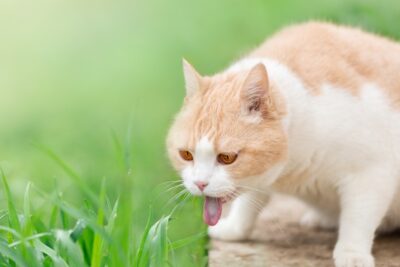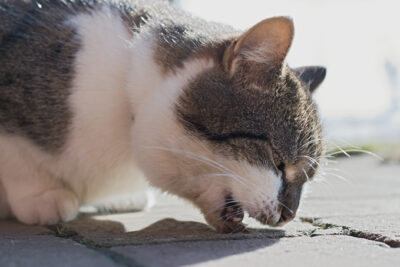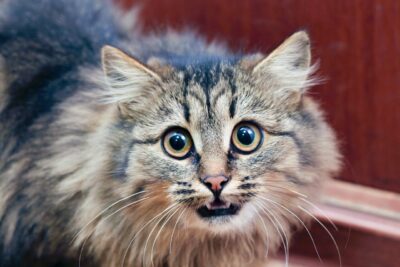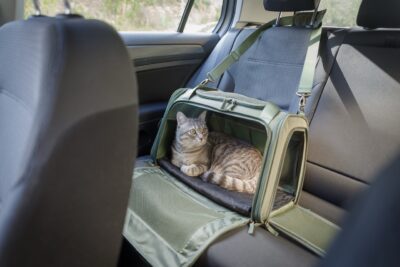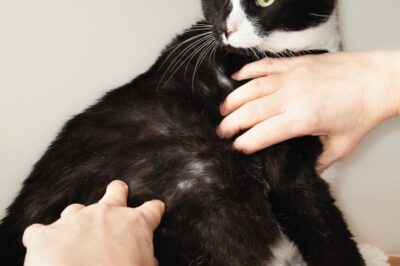Diabetes in Cats Treatment Plan: Steps and What to Expect
All featured products are chosen at the discretion of the GreatPetCare editorial team and do not reflect a direct endorsement by the author or reviewer.
Once a cat is diagnosed with diabetes, pet parents can feel overwhelmed by how to treat and manage the condition, especially since they may need to give their cat insulin at home. To help you along this journey, this article will share some treatment plan steps, as well as what you can expect when managing feline diabetes.
Diabetes in Cats Treatment Plan: What to Expect
Cat diabetes can seem overwhelming at first because there is a lot to learn, but it gets easier over time. Unfortunately, cat’s do not follow the ‘textbook’ on diabetes, and there can be a lot of trial and error to figure out the best way to treat your pet. Once your pet is diagnosed with diabetes, your veterinarian will likely create a treatment plan that will cover medication, diet, exercise, and treatment of any concurrent condition, such as obesity or a urinary tract infection.
Your veterinarian will likely start with a medication to control the diabetes, such as insulin, glipazide, or a new medication called Bexacat. They will also discuss the ideal diet for your pet, including how much and how often to feed. Exercise and weight control is an important part of diabetes management and will be addressed in your cat’s treatment plan. And lastly, the treatment of any other diseases or conditions that are present will also contribute to the success of your cat’s diabetes management.
Because there is no one size fits all approach to feline diabetes, your veterinarian’s plan might change along the way. After assessing your pet’s overall health status, they will create a starting place to begin treatment. Rechecking lab work can be frequent at first, sometimes weekly until the diabetes is well managed, then will occur at more sparse intervals. Changes will be made based not only on lab work results but also how your cat responds at home. This is why it is imperative for you to track your pet’s response at home to treatment, taking extra careful notes after any changes are made.
How to Give a Cat Insulin in 10 Steps

Since giving your cat insulin shots will likely be part of a veterinarian-recommended treatment plan, here are the steps you can take to ensure you do it safely:
Step 1: Take the insulin out of the fridge and mix it according to the instructions. Some insulin types need to be gently mixed while others need a more vigorous shake.
Step 2: Use an alcohol wipe on the top of the bottle. Turn the bottle upside down, and insert the needle into the rubber top.
Step 3: Use the syringe to draw up the correct amount of insulin. Remove any air bubbles by lightly flicking the syringe. Double-check check the amount that you are giving is correct.
Step 4: Use an alcohol wipe to disinfect the injection area on your cat.
Step 5: Using your non-dominant hand, gently pick up the loose skin in between your cat’s shoulder blades.
Step 6: In the area of lifted skin, insert the needle at a 45-degree angle and gently pull back on the syringe. If there is no blood, inject the insulin, and then withdraw the needle. If there is blood, withdraw the needle and try again. Enlist help if you need it.
Step 7: Check the injection site to make sure there is no insulin on the skin (wetness).
Step 8: Each time you inject insulin, try to slightly vary the site of injection to avoid scarring.
Step 9: Place the used syringe in a safe disposal container.
Step 10: It can help to have the veterinary staff shave a patch of fur where you are giving the injections so you can better visualize the skin.
Insulin pens are sometimes available depending on the needs of your pet. Instructions with the preparation of the pens vary slightly and it is important to follow your veterinarian’s instructions.
A glucose curve test is an all day test where your cat’s blood sugar is checked at regular intervals (usually every 2 hours) to see how your cat is responding to their insulin dose. While these can be helpful, they can also be stressful and cause your cat’s sugar levels to be artificially elevated. A discussion with your veterinarian will help you figure out the best option to monitor your diabetic cat.
Treating Diabetes in Cats Without Insulin
Cats that have uncomplicated Type II diabetes mellitus may be able to be managed without insulin. A newer alternative to insulin for treating feline diabetes is called Bexacat (bexagliflozin), a once-daily flavored tablet. It lowers blood sugar by increasing urine excretion of glucose through the inhibition of a membrane protein called SGLT2, which is found in the kidney. However, cats who have previously been treated with insulin, who are currently receiving insulin, or who have insulin-dependent diabetes should not use Bexacat.

Another alternative to insulin for cats with uncomplicated Type II diabetes mellitus is a drug called glipizide. Glipizide is a medication that works by stimulating the pancreas to release more insulin. It comes in tablets, oral flavored liquid, or a lotion that is rubbed on their skin.
In addition to medication, weight loss is necessary to treat overweight or obese cats with Type II diabetes mellitus. In fact, some cats may be ‘cured’ of Type II diabetes mellitus with weight loss and medication alone, and may not need to continue on medication for the rest of their life. It is always important to work closely with a veterinarian in order to monitor your cat’s clinical signs and blood sugar.
Diabetic Cat Diet: What to Feed

Nutrition is an important facet of cat diabetes treatment. Factors like food type and the way you feed a diabetic cat are important to success. Here are a few best practices to help:
Keep feeding times the same. The goal of feeding a diabetic cat is to match the blood sugar-lowering effect of insulin or glipizide with the blood sugar-raising effects of a meal. Most insulins are at their highest effect in a cat’s body 2-4 hours after injection. Unless otherwise directed by your veterinarian, feed your cat before giving insulin. Most diabetic cats do well with twice daily feedings, however, if your cat is a ‘grazer’, then you can free-feed a measured amount of kibble each day and add in a small meal of canned food morning and night in conjunction with insulin injections. If you can only inject insulin once a day, feed the day’s total calories in 2-3 meals within 6-8 hours of giving insulin. If you treat your cat with glipizide, then give glipizide at the same time you feed your cat in the morning and evening.
Keep everything consistent. The type of food, the amount, and the time you feed your cat should be the same every day, as much as possible. Pet owners often fail to achieve control of their cat’s diabetes because they are not disciplined with timed feeding. This can be very frustrating, so set yourself up for success with a consistent routine.
Follow your vet’s recommendation for food. When it comes to the type of food to feed a diabetic cat, pet parents should follow their veterinarian’s recommendations. Diabetic cats should eat a diet that is ultra-low in carbohydrates because carbs cause elevated blood sugar. In fact, low-carb canned foods may reverse diabetes in some newly diagnosed diabetic cats.
Diabetic diets for cats are low in carbohydrates and contain fiber to help cats feel full and promote intestinal health. Avoid soft-moist foods because they cause severe elevations in blood sugar.
For cats with food allergies or if you want to make a home-cooked diet for your cat, it is recommended to consult with a board-certified veterinary nutritionist so they can formulate a diet recipe for you that is complete and balanced.
Follow feeding recommendations for weight loss. Healthy weight loss is an important part of therapy in overweight diabetic cats and will lower the amount of medication required in most cats. Therefore, your veterinarian will prescribe restricted caloric intake until your cat achieves their ideal weight. This can usually be achieved within 2-4 months using a low-carb weight loss food.
Keep treats at a minimum. Diabetic cats should not be provided snacks or treats unless the treats have very low calories and no carbs. Providing 3-5 tiny pieces of white meat chicken or turkey can make a nice daily treat. Alternatively, you can hand-feed your cat’s kibble as a treat.
Have fresh water handy. Diabetic cats become dehydrated quickly if their blood sugar levels are too high. Keep fresh water available at all times, and if you notice they suddenly start drinking more, that could indicate that their blood sugar levels are too high. Call your veterinarian for a follow-up.
Diabetic Cat Exercise Plan

Having a regular exercise plan for your cat is another way to help regulate blood sugar levels and keep your feline happy and healthy. As with feeding, try to keep the exercise sessions at the same time each day. High-intensity exercise is not recommended, as it can cause abrupt changes in blood sugar levels. A stroll around the block on a harness or two moderate-intensity 15-minute play sessions at the same time each day are recommended.
In the event that your cat does experience low blood sugar while exercising, (which will look like weakness or collapse) you will need to raise your cat’s blood sugar quickly. The best way to do this is to rub a small amount of sugar on their gums, so always keep a small container of honey or corn syrup handy. It is also a good idea to ask your veterinarian for exercise recommendations for your cat, especially if your cat has any other health challenges.
Cat Diabetes Cost
How often a diabetic cat needs to see a vet depends on how well the cat is responding to therapy and if there are any other health complications, such as hyperthyroidism or kidney disease. Cats with uncontrolled diabetes or other disease conditions have higher veterinary bills than cats with uncomplicated diabetes.
Cats with uncomplicated diabetes that are well controlled with therapy should see the veterinarian every 3-6 months for a check-up and a laboratory test called fructosamine, which measures how well blood sugar is controlled over time. Glucose curve tests are unreliable in cats because stress can make a cat’s blood sugar go up.
Costs associated with cat diabetes include:
- Physical examinations cost $50-$100, every 3-6 months
- Fructosamine tests cost $60-$90
- At home urine glucose strips cost $15-$20/50 count
- A bottle of lente insulin costs $60-$70 and will last 2-3 months. You may be able to purchase insulin for less at big box retailer pharmacies or online
- Glipizidine costs $0.10/day to treat most cats
- A large bag of diabetic cat food costs $70-90, but should last you quite a while
- A case of canned diabetic cat food costs $50-$60
Diabetes in Cats Treatment: More Tips and Advice

When you are managing diabetes in cats, it is important to maintain a good relationship with your veterinarian and communicate on a regular basis. Additionally, here are some other things to consider as part of your cat’s treatment plan.
Keep detailed notes. Keep a journal of relevant information about your cat, including how much water they drink daily, weekly body weight, current insulin or glipizide dose, and how much food is eaten each day.
Watch for early signs of blood sugar issues. The early signs that blood sugar is not regulated included increased drinking and urination. If you notice this, call your veterinarian.
Pay attention to your cat’s urinary health. If your cat shows any signs of urinary tract infections (straining to urinate, increased urge to urinate, accidents in the house, bloody urine) or skin infections (pimples, red, flaky skin), call your veterinarian. If your female cat isn’t spayed, have her spayed.
Don’t use steroids. Avoiding using steroids, including hydrocortisone, on your cat. These can make diabetes worse. If your cat has skin allergies, ask your vet about alternative treatments that are safe for cats with diabetes.
Try at-home urine testing. Check for sugar in your cat’s urine at home with over-the-counter urine glucose strips. While they can’t tell you how high the sugar is, they can let you know that there is sugar so you can inform your vet.
Signs of hypoglycemia: Cats can enter remission from diabetes at random. It is important to know the signs of hypoglycemia (too low of blood sugar), which can include weakness, lethargy, depression, lack of coordination/stumbling, and seizures. If you notice any of these signs, contact your veterinarian immediately.
The good news is that a consistent routine of properly timed feeding and medication creates an excellent prognosis for cats with diabetes.
